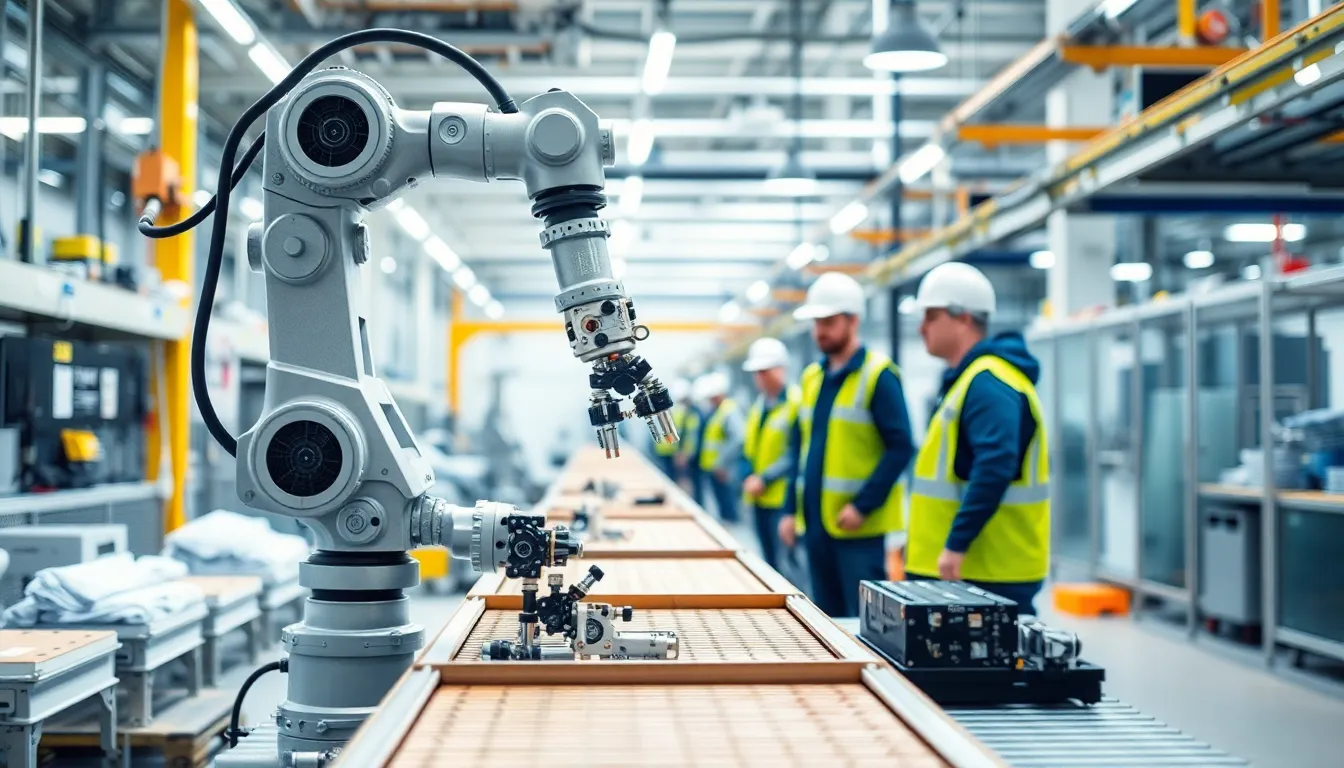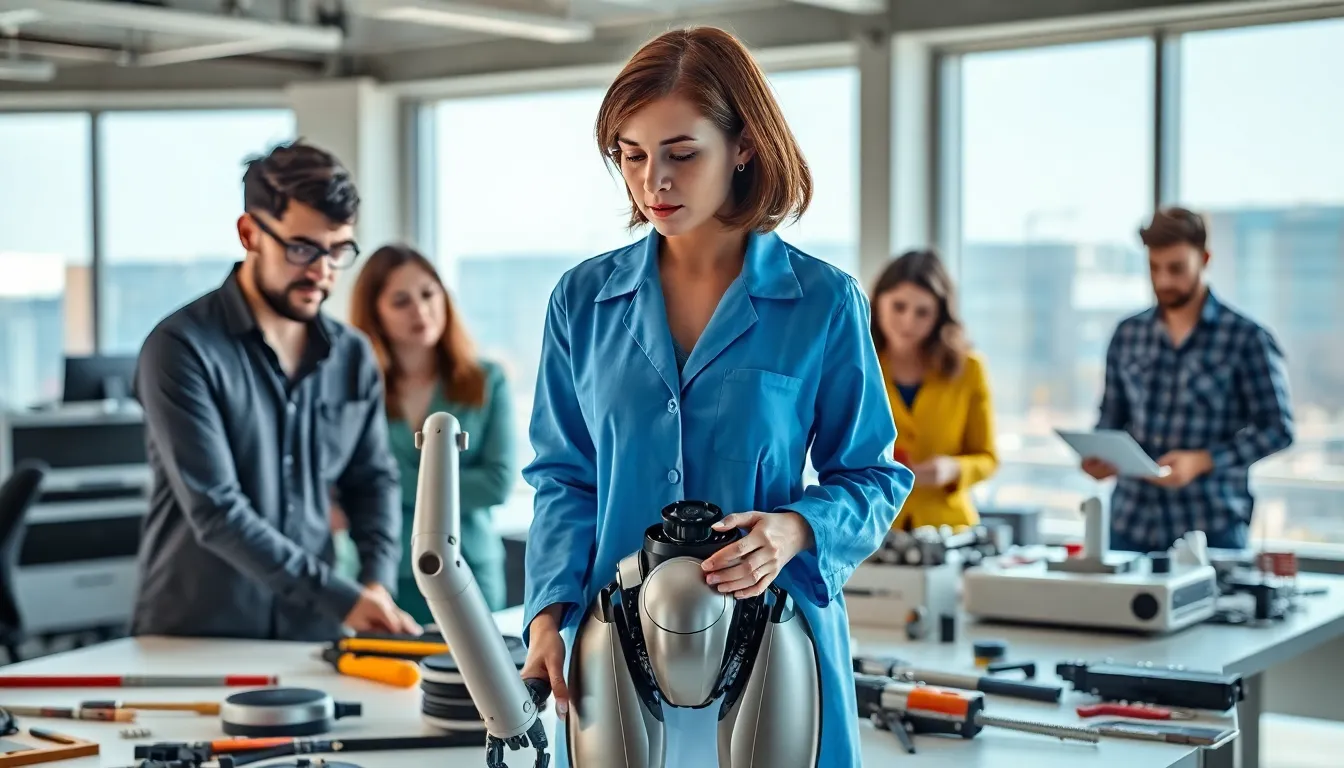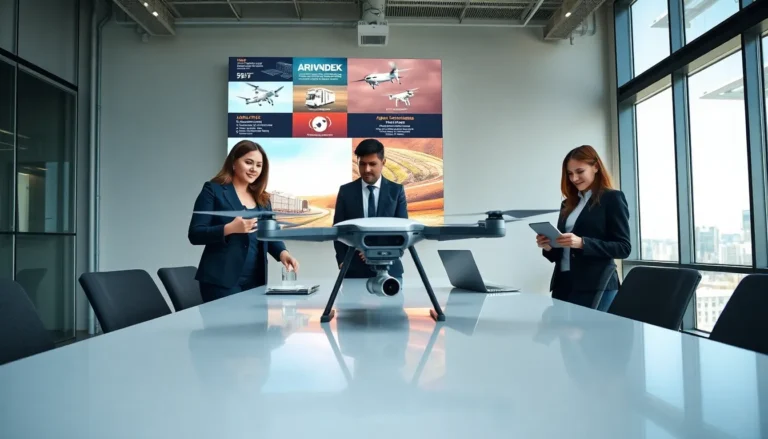Table of Contents
ToggleIn a world where robots are no longer just the stuff of sci-fi movies, the integration of these mechanical marvels into everyday life is becoming a reality. Imagine a workplace where your coffee is brewed by a friendly robot while another one handles the paperwork—sounds like a dream, right? Well, it’s happening now, and businesses are reaping the benefits faster than you can say “automation.”
Robot integration isn’t just about replacing human workers; it’s about enhancing productivity and creating a more efficient environment. From manufacturing floors to healthcare facilities, these high-tech helpers are transforming operations and making tasks smoother than a robot’s dance moves. So buckle up as we explore the fascinating world of robot integration and discover how it’s reshaping industries while giving humans a little extra time to enjoy that well-deserved coffee break.
Overview of Robot Integration
Robot integration encompasses the process of combining robotic systems with existing operations to streamline tasks. This transition enhances productivity and efficiency, particularly in industries like manufacturing and healthcare. Robots take on repetitive tasks while humans focus on complex decision-making.
Several types of robots play significant roles across various sectors. Industrial robots automate assembly lines, improving output rates. Service robots assist in hospitals, delivering medications and ensuring cleanliness. Collaborative robots, or cobots, work alongside human employees, providing support without replacing jobs.
Advancements in technology lead to improved integration methods. Machine learning and artificial intelligence enhance robotic capabilities, allowing them to adapt to changing environments. Data collection from robots improves operations by providing insights into performance metrics.
Implementing robots requires careful planning and strategy. Organizations conduct assessments to determine which processes benefit most from automation. Successful integration depends on training employees to work effectively with robots, ensuring a smooth transition.
Assessing ROI from robot integration is crucial for companies. Increased production rates and reduced labor costs contribute to a favorable financial outcome. Industry reports indicate that firms integrating robots experience significant growth compared to those that do not.
Global trends highlight the shift towards greater robot adoption. Regions like North America and Europe lead in integration efforts, driven by the pursuit of operational excellence. With support from governments promoting technology, robot integration is poised for accelerated growth.
Benefits of Robot Integration

Robot integration provides numerous advantages across various industries. Businesses experience significant enhancements in productivity and operational processes through the use of technology.
Increased Efficiency
Efficiency improves significantly with robot integration. Robots excel in performing repetitive tasks, allowing employees to concentrate on complex duties. Routine processes, like assembly line work in manufacturing, typically see substantial speed increases. For example, robots can operate continuously without breaks, which optimizes production schedules. In healthcare, automation reduces patient wait times by swiftly handling administrative tasks. Companies that embrace robotics experience quicker turnaround times, translating to higher throughput rates and greater overall productivity.
Enhanced Precision
Precision benefits from integrating robotic systems into workflows. Robots perform tasks with consistent accuracy, minimizing the likelihood of errors. For instance, in manufacturing, robots can assemble components to exact specifications, ensuring product quality. Medical robots assist in surgeries, maintaining precision that surpasses human capability. Data shows that automation in critical processes lowers error rates significantly. By ensuring meticulous execution of tasks, organizations can enhance customer satisfaction through superior product and service quality.
Challenges in Robot Integration
Robot integration poses several challenges that organizations must navigate to realize its full potential. Understanding these challenges aids in implementing successful robotic systems.
Technical Barriers
Technical barriers often impede the effective integration of robots. Legacy systems may lack compatibility with new robotic technologies. Inadequate infrastructure can result in communication issues between machines. These challenges necessitate significant investment in updating existing equipment. Further, complex programming may require specialized skills that many employees lack. Organizations must address these gaps to facilitate seamless robot implementation. A robust IT strategy that involves comprehensive testing can mitigate technical issues.
Workforce Adaptation
Workforce adaptation presents another critical challenge during robot integration. Employees may resist changes due to fears of job displacement. This uncertainty can lead to decreased morale and productivity. Training programs become vital for equipping staff with new skills, fostering a collaborative environment between humans and robots. Open communication regarding robots’ roles enhances understanding and acceptance among workers. A supportive transition space encourages employees to embrace automation rather than view it as a threat. Ultimately, adapting the workforce can maximize the benefits of robot integration.
Best Practices for Successful Robot Integration
Successful robot integration hinges on careful preparation and strategic planning. Organizations must assess and prioritize processes that stand to benefit the most from automation. Identifying areas with high potential for efficiency gains lays a solid groundwork. Establishing clear goals and metrics ensures that expectations align across teams. Organizations should engage stakeholders early, encouraging input to foster a sense of collaboration. Involving IT departments early on is crucial, as they play a vital role in ensuring compatibility with existing systems.
Planning and Strategy
Planning drives successful robot integration. A detailed analysis of current workflows helps pinpoint inefficiencies that robots can address. Aligning robotic solutions with business objectives enhances outcomes. Assessing costs and ROI creates a realistic budget, which streamlines the decision-making process. Organizations gain insights from pilot programs by testing smaller-scale implementations before scaling up their efforts. Commitment to iterative processes allows for adjustments based on feedback, resulting in continuous improvement. Flexibility during implementation enables companies to pivot as needed in response to unforeseen challenges.
Continuous Training and Support
Training remains essential for effective robot integration. Ongoing educational programs equip employees with the skills necessary to collaborate with robots. Emphasizing hands-on experience fosters confidence, helping workers adapt to new technologies. Support systems, including mentorship and access to expert resources, create a culture of continuous learning. Communication about robots’ roles alleviates fears about job displacement, showing employees how technology complements their work. Organizations should actively solicit feedback on training initiatives to enhance effectiveness, ensuring that staff feels valued during the transition. Regular updates on new features and capabilities keep teams informed and engaged.
Future Trends in Robot Integration
Increased reliance on automation will characterize future trends in robot integration. Adoption rates of robots across industries such as manufacturing and healthcare are set to surge, driven by advancements in artificial intelligence and machine learning. Collaborative robots, or cobots, are expected to become more prevalent, enhancing teamwork between human workers and robotic systems.
Industry experts predict that robotics will evolve to handle more complex tasks, moving beyond repetitive actions. Enhanced sensors and improved programming capabilities will enable robots to operate safely alongside humans in dynamic environments. Adoption of Internet of Things (IoT) technology will facilitate seamless communication between machines, optimizing workflows and boosting efficiency.
Investments in robotic systems will focus on flexibility. Organizations may prioritize versatile robots that can adapt to various tasks without extensive reprogramming. Enhanced training programs will support workforce adaptation by equipping employees with necessary skills to work alongside advanced robotic systems.
Regulatory frameworks are likely to evolve, providing clearer guidelines for safe robot integration. Compliance with safety standards will remain crucial as robots increasingly enter sensitive sectors such as healthcare. Furthermore, collaborative platforms may gain traction, connecting companies with tech developers to leverage robotics innovations.
Enhanced data analytics will play a pivotal role in evaluating robot performance and maximizing ROI. Organizations can expect to analyze operational metrics systematically to drive continuous improvement. As competition intensifies, effectiveness and precision in processes will become more critical, solidifying the role of robots in achieving operational excellence.
Strategically prioritizing robot integration will allow organizations to harness new trends effectively. Organizations adopting proactive approaches to automation will encounter increased productivity and efficiency. Continuous advancements in technology will shape robot integration’s future, paving the way for a more automated and efficient workplace.
Robot integration is reshaping industries and redefining the workplace. As organizations embrace this technology, they unlock new levels of efficiency and productivity. The collaboration between humans and robots not only streamlines operations but also enhances job satisfaction by allowing employees to focus on complex tasks.
By investing in the right technologies and training, companies can navigate the challenges of integration. The future promises even greater advancements as robots become more capable and adaptable. As industries continue to evolve, those that prioritize effective robot integration will lead the charge toward a more automated and efficient future.






